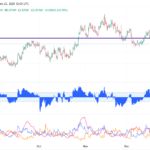What if tariffs are just the tip of the iceberg in a fierce currency war? The Trump administration is determined to end the era of America “paying for the world,” and tariffs are only the beginning of a broader strategy to revive U.S. industrial competitiveness. At the heart of this plan lies a push to weaken the “overvalued” dollar—blamed for America’s economic challenges. Is de-dollarization already taking shape? Explanations by Pierre-Antoine Dusoulier, Founder & CEO iBanFirst, a leading provider of foreign exchange and international payment solutions operating in 10 European countries.
The specter of devaluation
Since late January, the prospect of new global monetary agreements, dubbed the “Mar-a-Lago Agreements” has been gaining traction. This renewed plan stems from a paper by Stephen Miran, now head of the White House Economic Council, proposing a restructuring of the global monetary system. His two main points: the dollar is significantly overvalued (by 10–37% depending on the currency), and other countries should help shoulder the burden of the U.S. deficit. Miran suggests converting U.S. Treasuries into long-term, low-yield, perpetual bonds and tying trade, capital flows, and military influence into a U.S.-controlled hegemonic framework.
In this context tariffs are both as a response to “an injustice” and as an additional piece in the giant tug-of-war against the presumed global trade conspiracy. According to them, the dollar’s status as the international reserve currency is the root of the U.S.’s main economic problems.
A biased analysis
The U.S. faces undeniable structural challenges. Its share of global industrial production has dropped from 22% in 2004 to just 15%, while China’s is now double. Europe, without reserve currency status, has followed a similar path. Factories relocated because wages in Asian economies still represent only a fraction of those in the U.S.
Even with tariffs of 50%, it is unlikely that Apple would relocate iPhone production back to the U.S.
The U.S. trade deficit is primarily the result of a systemic imbalance between savings and consumption. While the U.S. has accumulated public and domestic debt to support consumption, countries like Germany and China have financed this consumption by saving.
The U.S. can’t simply return to a “Made in America” model—its labor market is tight and inflation has eroded incomes. Ironically, protectionism may harm the very workers it aims to help. Stagflation looms.
From de-dollarization to de-Americanization
The end of the “American burden”, a strong dollar, as seen by the Trump administration, may finally come, but not to the benefit of the U.S. While the dollar still holds a dominant position in global trade, the recent surge in gold purchases by central banks is a red flag. In January alone, 117 tons of gold were bought (excluding the Fed), compared to a historic monthly average of just 17 tons. Even more striking: U.S. institutional investors are turning to physical gold—despite its cost and illiquidity—a clear sign of growing doubts about the dollar’s future.
De-dollarization, once a distant scenario, is now taking shape—bringing with it high volatility in the euro-dollar pair and across global currencies, forcing companies to hedge even more. The dollar is no longer a safe haven and there is no other currency to replace it. Recession looms. And each passing day confirms it: there can be no “America Great Again” without “International Great Again.”

























